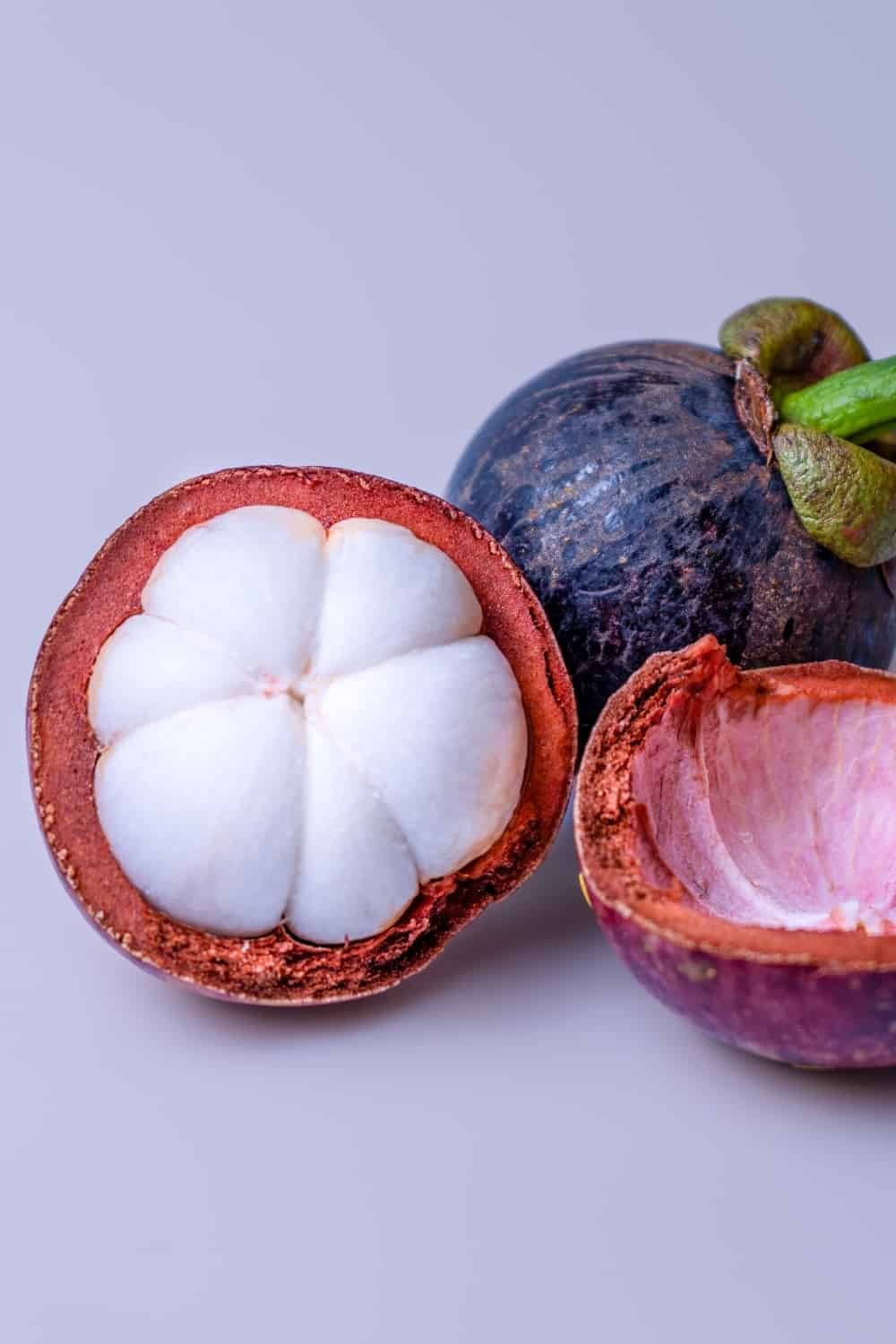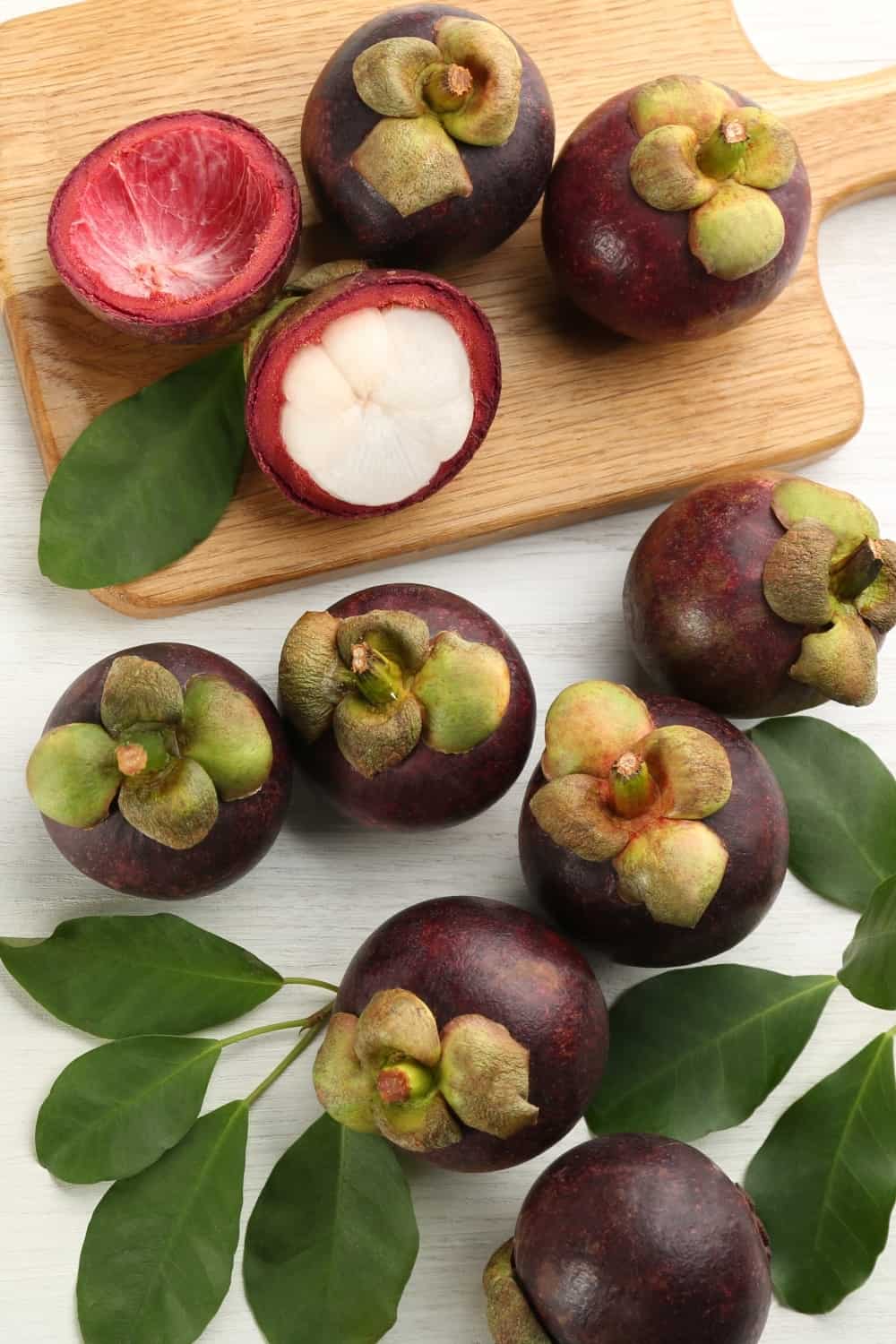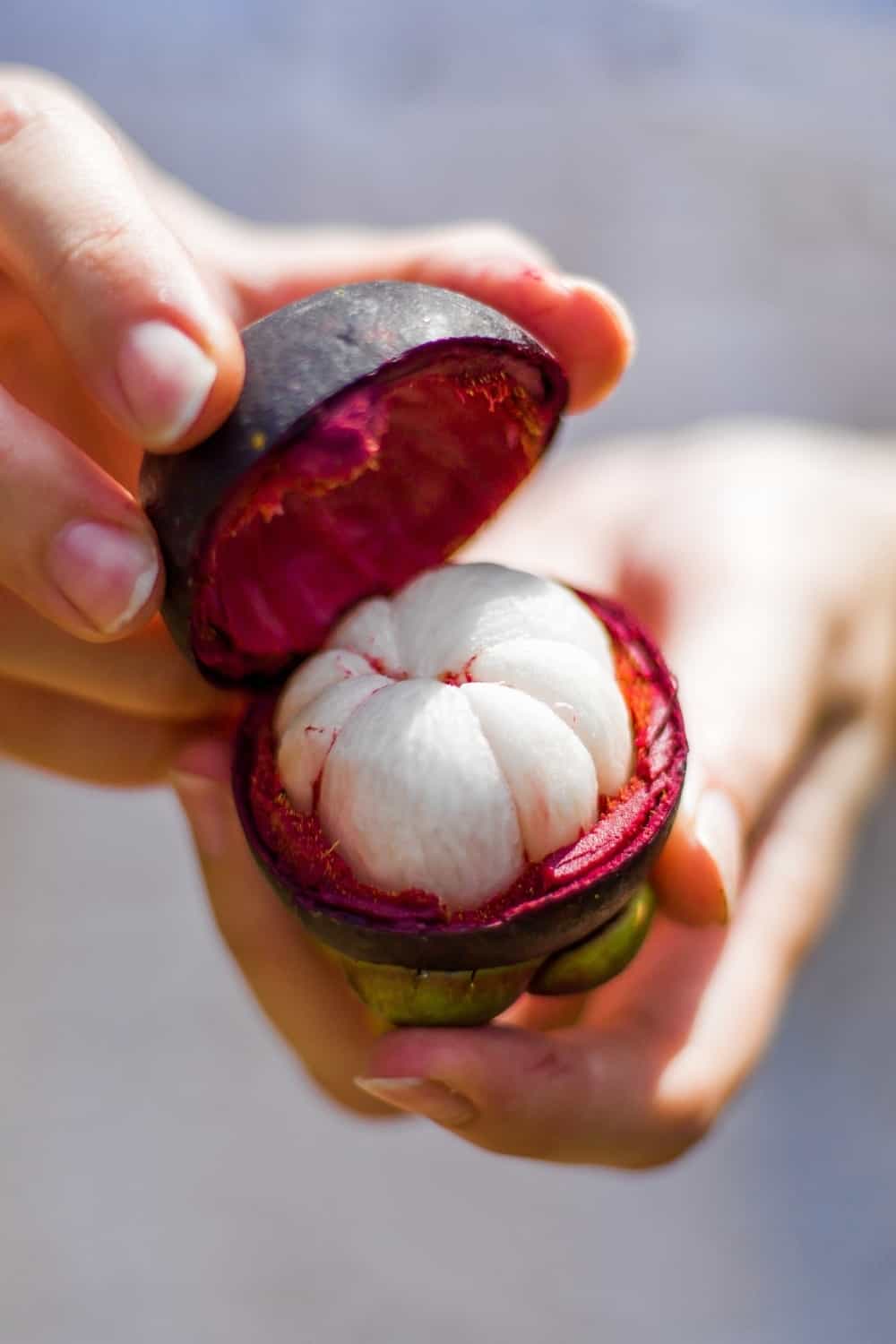It is one of those fruits that you won’t easily find on the shelves of supermarkets and grocery stores.
It is mangosteen, a tropical fruit native to Southeast Asia, also known as the “queen of fruits”. Since it is that type of fruit that spoils very fast after picking from the tree, it is not so accessible and that has been the case throughout history.
So, there is a rumor that, in 1890, Queen Victoria said that she would grant knighthood to anyone who brought her one. That’s how mangosteen got its crown.
However, it can also be said that it deserves the crown due to its nutritional value and wonderful complex taste. But, the real question is “What does mangosteen taste like?”.
Well, to start with, the mangosteen flavor is a delicious mix of lychee, strawberry, peach, and pineapple flavors.
But, there is so much more to say about mangosteen flavor, and, in this article, you will find out all the important facts.
What Does Mangosteen Taste Like When Ripe?

There are many varieties of this fruit that starts with M and it wouldn’t be easy to tell this about all the types. So, I will talk about the flavor profile of the most popular and accessible type, the purple mangosteen.
But don’t worry, below, you will be able to find out what other types of mangosteen taste like as well.
It is never easy to describe the complex flavor profile of tropical fruits, and the mangosteen is no exception.
First, the dominant flavor in mangosteen is the sweet flavor, almost similar to the sweet version of a peach.
However, unlike peach, mangosteen also has that tangy edge that resembles the citrusy flavor of lemon or orange, but just to a smaller extent.
And, unlike many other types of fruits, mangosteen can also provide a luscious vanilla essence, making it especially divine.
In terms of complexity, there is really no great match. One that comes the closest is lychee, another tropical fruit with a complex flavor.
However, its flavor range is a little “warmer” and leans a little toward spice.
Finally, a very ripe version of strawberry tastes quite similar since it is also very sweet and has a bit of an edge, similar to citrus.
However, it is less intense than mangosteen and offers a bit more complex flavor experience.
Below is a table of the three dominant flavors in mangosteen.

A Very Pleasant Texture Of Mangosteen
Also, I simply must mention the texture of mangosteen because that is a huge part of the overall tasting experience.
In one sentence, its texture can be described as juicy, soft, and light. It is slightly fibrous and chewy to some extent.
The flesh of mangosteen is delicate and quite tender, and it can be easily separated from the thick rind by gently pressing and twisting the fruit.
When compared with other fruits, the texture of lychee comes closest, as well as that of grape to some extent.
What Does Unripe Mangosteen Taste Like?

Although it can be used in some dishes, like in some savory recipes, unripe mangosteen can be quite unpleasant and most people don’t find it very attractive.
But, how to recognize it, and what is its taste and texture? Well, unripe mangosteen has a green color and it is quite thick when compared to the ripe version. Also, it is quite difficult to open.
The flesh inside is slightly sour and more bitter than that found in ripe mangosteen.
It is also harder, more fibrous, and less juicy when compared to ripe mangosteen. This is what makes it so unpleasant to many people, including myself.
I once had a chance to taste unripe mangosteen and I found it somewhat stringy and quite fibrous. Aside from that, the bitter flavor was very dominant and that was very unpleasant.
However, one good friend of mine who cooks a lot with tropical fruits, said that it is not worthless because it can be used in some savory dishes where its tartness can provide a flavorful contrast to other ingredients.
Particularly, it is mostly used in curries, salsas, and stir-fries with some other veggies and meat, giving the dish a tangy and slightly crunchy element.
Does Frozen Mangosteen Have A Different Flavor?

Mangosteen is a very perishable fruit and it is known that freezing can make many foods last longer.
But, is that the case with mangosteen, many would ask? Well, technically, you can freeze mangosteen, but that will alter its flavor and texture dramatically.
Namely, the freezing and thawing processes will cause your mangosteen to lose most of its juices. So, it will be quite dry and even mushier than a fresh one.
Aside from that, mangosteen will lose its recognizable sweet flavor and that tangy edge as well. It will taste somewhat bland with a bitter flavor.
Now that you know what happens to the flavor and texture of frozen mangosteen, it is not difficult to conclude that it is not a good idea to freeze this precious fruit unless, of course, you don’t want to ruin it on purpose.
What About The Canned Mangosteens Flavor Profile?
As you already know, it is very hard to find fresh mangosteen because, first, the climate in the USA is not its thing and, second, it is a highly perishable food that degrades as soon as it gets on your plate.
Due to this fact and the fact that mangosteen has a wonderful, unique flavor and amazing nutritional profile, many people try to find it and enjoy it in different forms.
And one of those is canned mangosteen. But, is it worth it? What does canned mangosteen taste like? Well, the fact is that canned mangosteens’ flavor profile is different because some type of syrup or juice is added.
That syrup or juice affects the flavor profile of canned mangosteen to some extent. And since some additives and sweeteners are also added, canned mangosteen may be a bit sweeter than fresh ones.
Also, the texture of canned mangosteen is a bit softer and less fibrous, and the seeds inside the fruit may be less noticeable or even absent, but that depends on how it is produced.
Ideally, there are producers that make canned mangosteen in its own juice and that type resembles the flavor of fresh mango the best.
But unfortunately, it is hard to find canned mango that is made like this.
What Is The Flavor Profile Of Other Varieties Of Mangosteen?

Aside from purple mangosteen which is the most common variety, there are some other varieties that have slightly different flavors and textures so let’s introduce you to them.
White Mangosteen
Aside from the obvious differences in color and availability, there are some slight differences in flavor and texture between the two mangosteen varieties.
First, purple mangosteen has a stronger and more complex flavor profile when compared with white mangosteen.
It can also be said that white mangosteen is a bit sweeter in taste compared to purple mangosteen, which is often described as having a more intense and tart flavor.
Both mangosteen varieties have a soft, delicate texture, but the texture of white mangosteen is slightly more tender, which can make it more substantial in the mouth.
Green Mangosteen
This variety has a greenish-yellow color on the outside and is slightly smaller than the purple mangosteen.
Unlike white mangosteen, the green variety has a slightly sour taste compared to the sweeter purple mangosteen.
When you compare the textures of these two varieties, you can easily notice that the green mangosteen has a thicker rind, which makes it slightly more challenging to open.
The flesh of green mangosteen tends to be firmer and contains less juiciness than that of purple mangosteen.
Yellow Mangosteen
Yellow mangosteen is an incredibly rare variety, but it can be found in some parts of Southeast Asia, particularly in Indonesia and Malaysia.
Its rind has a nice yellowish-green color, which is a bit thicker when compared with that of purple mangosteen.
Also, the flesh is a bit firmer and less juicy and its texture can be described as slightly rubbery.
Both purple and yellow mangosteen have a sweet, tangy, and slightly acidic flavor, but the flavor of the yellow mangosteen is often described as being slightly milder and less complex.
It can also have a slightly more citrusy taste.
Red Mangosteen
Aside from having a distinct reddish color, the red variety of mangosteen tends to be sweeter than purple mangosteen.
Aside from that, the flesh is a bit creamier, but it doesn’t have the same level of juiciness as purple mangosteen.
If you have some red mangosteen and want to eat it fresh, it is advisable to get rid of the seeds because they taste very bitter.
Button Mangosteen
Although both are varieties of mangosteen, purple, and button mangosteens have quite distinct flavors and textures.
Unlike the purple variety, button mangosteen has a stronger sour flavor that can be compared to green apple or lime. It is also less sweet than purple mangosteen but still has a pleasant taste.
When it comes to texture, button mangosteen is a bit firmer and is often described as being crunchy, with a more fibrous interior.
It also has a smaller seed and that seed is often eaten along with the flesh.
Lemon-Drop Mangosteen
From the name itself, you can deduce what flavor is dominant in this mangosteen variety.
Well, it is the flavor of lemon, i.e. a tangy and citrusy flavor with a slightly sour taste.
Unlike purple mangosteen, this variety lacks sweetness and people who tried it did not find it very appealing.
The texture is not ideal either. Namely, it has a firmer texture and it is often described as being crunchy, with a more fibrous interior.
I also have to emphasize that lemon-drop mangosteen has a yellowish-green rind, unlike purple mangosteen, which has a deep purple rind.
How To Eat Mangosteen And Enjoy Its Flavor

It is ideal to enjoy mangosteen fresh if you have the chance, because, only that way can you experience the plate of the different flavors and the juiciness it can offer.
Although it is not very common, you can also cook mangosteen and incorporate it into some types of dishes. So, let’s see what its different uses are and how it tastes in those different types of dishes.
• Stir-fries: Mangosteen is mostly used in Asian cuisine as an addition to stir-fry. There, it is combined with some veggies (garlic, onion, vegetable broth), meat (mostly chicken), and some other ingredients (oil, red bell pepper, green bell pepper, soy sauce, corn starch), as well as some salt and black pepper (ground or cracked black pepper).
Mangosteen adds a sweet and slightly tangy flavor to the dish, which pairs well with the savory flavors of the veggies and sauce. It also adds a nice contrast to stir-fries in terms of texture.
• Desserts: In my opinion, this is one of the best ways to use mango if you don’t eat it fresh. It can be added to various types of desserts, from puddings and sorbets to cakes and pies.
Wherever you choose to use it, my recommendation is to combine it with the flavor of coconut milk, especially if you are making pudding. The rich and nutty flavor of coconut milk perfectly complements the sweetness of mango.
The dessert made with mango is refreshing and light, making it perfect for a summer treat.
• Curry Dishes: In some countries in Southeast Asia, mangosteen is often used in Thai curry dishes. And that is actually the best way to use it in curries.
Mangosteen adds a natural sweetness which helps to balance out the spiciness of the curry, as well as a slight sourness to add a tangy flavor to the dish.
On the other hand, ingredients like chili, lemongrass, and ginger add just enough spiciness to the dish.
And there is also coconut milk that often goes in these types of curries and it adds a creamy and savory flavor to the meal.
If you want to know how to eat mangosteen and make yourself a delicious mangosteen curry, watch this video.
• Grilled Mangosteen: Finally, grilled mangosteen is really a unique experience when it comes to flavor and texture.
Generally, only the flesh of mangosteen is grilled and, in that process, it tends to caramelize and release its natural sugars, which makes it even sweeter.
That sweetness is perfectly combined with the smoky flavors from the grill and the heat of the grill also enhances the natural flavors of the fruit, making it more intense and complex.
The texture is softer and slightly chewy, which makes it quite an appealing combination.
Mangosteen Flavor Compared To Similar Fruits

Finally, here are some interesting taste comparisons with some other similar fruits.
Mangosteen Vs Mango
I hear a lot of questions in terms of the differences and similarities between these two fruits. And although they have similar names, they are actually not the same fruit and are not related at all.
They even come from different countries, Mangoes are native to India and that is their main exporter.
While mangosteen has a dark-purple skin with white flesh inside, mangoes are reddish green outside with a yellow-orange pulp on the inside.
Finally, when it comes to flavor profiles, mangoes don’t have as complex flavor profiles as mangosteen. It is true that they are both sweet fruits, but a mango has a more fruity, citrusy flavor and, when overripe, it may also have a hint of musk.
It also contains a slight acidity.
The flesh of the mango is also juicy, but it is firmer and less delicate than mangosteen’s flesh. Mango has a somewhat stringy texture, with fibers running through the flesh that can sometimes get stuck in your teeth when you eat it.
Mangosteen Vs Lychee
I already stated earlier that mangosteen and lychee are two similar fruits in terms of their flavor profile complexity. But what exactly are their similarities and their differences?
Well, a lychee does not have such a complex flavor profile as mangosteen. They are both juicy and refreshing fruits, but unlike mangosteen, lychee has a combination of sweet and fragrant flavors, with a slightly tart undertone.
Also, lychee is firmer than mangosteen and has a somewhat bouncy texture. The flesh is more watery than mangosteen, and its texture can be described as jelly-like to some extent.

